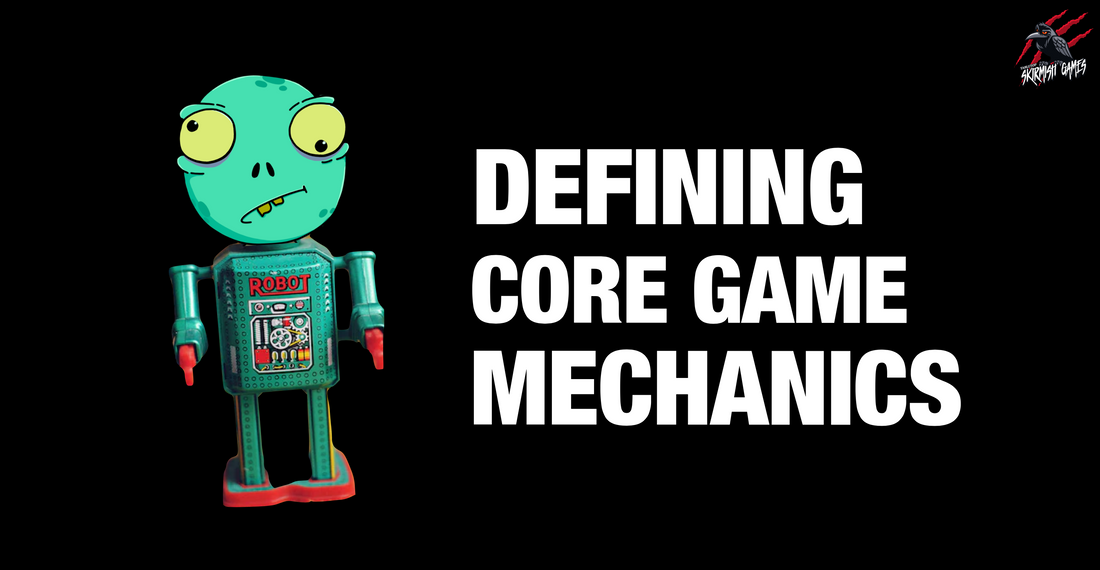Rules of Engagement: Defining Tabletop Skirmish Game Core Mechanics
At the heart of tabletop skirmish games lies a crucial element that shapes the entire gaming experience – core mechanics. In this blog post, we'll delve into the importance of defining core mechanics in a tabletop skirmish game. We’ll discuss how five main elements work together to create an enjoyable gaming experience.
The Backbone of Tabletop Skirmish Games:
Tabletop skirmish games, with their fast-paced and strategic nature, demand a solid foundation in the form of well-defined core mechanics. These mechanics act as the backbone, dictating how players interact with the game scenarios and make decisions. By establishing clear and concise rules for movement, combat resolution, abilities, resource management, and interaction with the environment, game creators set the stage for a challenging and immersive experience.
5 Main Elements of Core Mechanics:
Movement:
In tabletop skirmish games, how characters traverse the battlefield significantly influences overall strategy. Defining movement mechanics not only impacts tactical decisions but also contributes to the flow of the game. From line-of-sight (LOS) and cover systems to how models navigate obstacles, a well-thought-out movement system enhances the depth of the gaming experience.
For instance, defining movement in inches, as seen in games like Necromunda, makes interactions with enemy models more precise and involved. In contrast, games like Zombicide use zones, making movement more regimented and predictable.
Combat Resolution:
The thrill of tabletop skirmish games often lies in combat encounters. Core mechanics should provide a clear and balanced combat resolution system. Whether it's a dice-based combat system, like in Population Z, or a card-driven mechanism, as seen in Moonstone, the goal is to ensure that combat feels impactful and rewards strategic planning.
Playing with the combat resolution system can totally change how a game flows. For example, creating a combat resolution system that gives a greater chance of causing damage in close combat will nudge players to try to close down the enemy and perhaps be more aggressive with their movement.
Abilities:
Unique abilities add a layer of complexity to tabletop skirmish games, allowing players to differentiate their characters and develop diverse strategies. Defining the mechanics behind these abilities requires a delicate balance to prevent any one ability from dominating the gameplay while ensuring each contributes meaningfully to the overall experience.
Abilities can also help progress and deepen narrative if incorporated into the backstories of the characters, bonding characters together, giving buffs if they work together, for example.
Resource Management:
Tabletop skirmish games often involve the careful allocation and management of resources, be it ammunition, energy, weapons, or special abilities. Core mechanics governing resource management should strike a balance between scarcity and abundance, creating tension and meaningful choices for players.
This balance can be achieved through careful scenario planning and working with dice probability to ensure there is a good sense of risk and reward. For example, in Core Space, searching is an important part of the game, but as the threat level increases, the risk of using limited actions to search leaves players vulnerable to attacks.
Interaction with the Environment:
A dynamic and interactive environment enhances immersion. Core mechanics must allow players to engage with the environment strategically. Whether it's using cover, leveraging elevation, or interacting with objects and NPCs, the environment should be more than just a backdrop or collection of terrain.
In Population Z, NPCs play a huge part in the environment, helping to ‘bring it to life’ by posing problems for players to solve or sometimes helping them achieve objectives. Including weather effects, traps, and potential threats adds to the excitement and makes the battlefield as important as the miniatures.
Importance of Clarity, Intuitiveness, and Balance
On top of the 5 main elements of Core Mechanics that we’ve just looked at, it’s helpful to keep Clarity, Intuitiveness and Balance in mind. Let’s look at each of these now.
Clarity:
Clear and concise core mechanics are one, if not the most important thing to strive for when creating a tabletop skirmish game. Ambiguity can lead to frustration and hinder the fluidity of gameplay. When players understand how each element works, they can focus on devising and executing strategic plans, elevating the overall gaming experience.
There’s nothing worse than having to go back and forth to a book to clarify wordy rules that aren’t clear in their meaning. Leaving room for opposing interpretations of a rule can often spoil a potentially good interaction.
Intuitiveness:
Tabletop skirmish games thrive on quick decision-making. Intuitive core mechanics enable players to grasp the rules swiftly, reducing the learning curve. An intuitive system ensures that players can concentrate on their characters and abilities rather than grappling with complex rules.
We saw how unintuitive Kill Team became when the shape mechanic was introduced. The Pentagon representing 6” where a Hexagon would be an obvious and more intuitive choice. A triangle representing 1” would instead be more at home representing 3”, and so on.
Balance:
Achieving balance in core mechanics is an art. Whether it's balancing movement speed with defensive capabilities or ensuring that powerful abilities have corresponding drawbacks, a balanced system fosters fairness and keeps the game competitive.
Balance between factions is another topic, and this can certainly dominate the conversation where competitive games are concerned. I argue that balance outside of the core mechanics shouldn’t take front and center. Life isn’t balanced, and in historical gaming with games like Bolt Action, it’s interesting, challenging, and fun to go into a scenario where the sides aren’t balanced. When the underdog wins, it creates such a great experience.
Rules of Engagement: Tabletop Skirmish Game Core Mechanics Defined
In the intricate tapestry of tabletop skirmish games, defining core mechanics is an art that requires a delicate balance of strategy, intuition, and clarity. A well-crafted system, encompassing movement, combat resolution, abilities, resource management, and interaction with the game world, lays the foundation for an immersive and enjoyable gaming experience.
For me, Tabletop Skirmish Games should be exciting, fun, and social times to get together with our friends and families to tell stories and create awesome memories. A solid set of core mechanics helps create these good times, and focusing on the 5 main elements is a great starting point for any game creator.
I hope you enjoyed this blog post and found it helpful. I’d love to hear your thoughts and opinions on the subject, so join in the conversation in the comments below.
Thanks for reading!
Lee
Look out for my new game, Population Z: Welcome to Huntsville, launching in January 2024.

